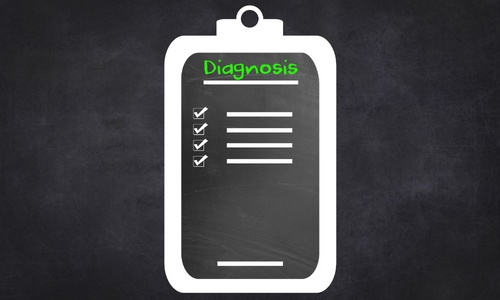PES Statement Examples for Dietitians
“PES Statement Examples for Dietitians” was written by Aly Maranges & edited/reviewed by Aly Bouzek, MS, RDN.
A PES statement is an organized sentence that gives a nutrition diagnosis.
This statement concisely describes the dietitian’s diagnosis for the patient, explains why that individual diagnosis was made (with evidence that it is present), and states the nutrition problem that the dietitian will be finding a solution for.
PES statements should be easily written for all health professionals to understand.
Nutrition Care Process

Before we get into the specifics of PES statements, we’ll first learn about the Nutrition Care Process.
This is a standardized model that helps dietitians provide patients with superior personalized nutrition care.
The Nutrition Care Process provides a consistent structure to use when providing nutrition care for patients with any diseases or health conditions.
As mentioned previously, the nutrition diagnosis is one of the steps in the Nutrition Care Process, which is where the PES statement is found.
The nutrition diagnosis represents a particular nutrition problem that the dietitian is in charge of treating/solving.
In many situations, more than one nutrition diagnosis can be made for the patient. The nutrition diagnosis is expressed using nutrition diagnostic terminology. Read on to learn more!
ADIME
The Nutrition Care Process has four sections and is commonly remembered with the acronym ADIME:
- (A) Assessment
- (D) Diagnosis → (PES statement falls into this category)
- (I) Intervention
- (M) Monitoring and (E) Evaluation
Nutrition Care Process in Detail
The nutrition assessment is the first step in the Nutrition Care Process and includes patient information regarding:
- history of nutrition/food intake
- anthropometric measurements
- lab test results, medications, procedures
- physical findings (found through a nutrition-focused physical exam)
- patient medical history
The nutrition diagnosis is where the PES statement comes into play (we’ll explain more below). This is used as a NUTRITION diagnosis, not a medical diagnosis.
The nutrition intervention is to figure out what and how the dietitian can do to help improve the patient’s health. The intervention builds off of the nutrition diagnosis (above).
Nutrition monitoring and evaluation is noting how the patient’s health journey will be measured and, if needed, adjusted. All following appointments will look at the patient’s progress to see if their health is improving or if a different approach would be a better fit.
How to Write a PES statement
Writing a PES statement can feel overwhelming at first. That’s why we are going through it step-by-step to help you feel prepared and ready to write them on your own.
Take a deep breath and follow the formula below!
Three Components
The PES statement has three distinct components:
- P (problem)
- E (etiology)
- S (signs and symptoms)
PES Statement: Problem
The problem in a PES statement is also known as the nutrition diagnosis.

What is the patient struggling with that a dietitian can help solve?
If you’re unsure of the problem, then ask yourself, “Can a dietitian improve this?”
If the answer is yes, then that means the problem is within the dietitian’s scope of practice and they can help with treatment.
The problem, or nutrition diagnosis, will always be in one of these three categories:
- Intake: problems related to intake of energy, fluids, nutrients, through oral diet or nutrition support
- Clinical: problems related to any physical or medical reasons related to nutrition
- Behavioral/Environmental: problems related to nutrition knowledge (or beliefs surround particular food/s), access to safe food, and function and physical activity surround nutrition (i.e. troubles with self-feeding, exercise, self care, etc.)
Determining which of the three categories that the nutrition diagnosis falls under will better help you to individualize and truly understand the patient’s current nutrition problem(s).
PES Statement: Etiology
The etiology in a PES statement describes the cause or causes of the nutrition diagnosis (the problem).

What is the cause of the problem?
What is the reason for the patient having a nutrition diagnosis?
If you’re unsure of what the etiology should be in your PES statement, then ask yourself, “What led to this patient having this nutrition diagnosis?”
The etiology helps determine the intervention in wanting to reduce or minimize the main cause of the problem.
PES Statement: Signs and Symptoms

The signs and symptoms are the specific evidence and quantifiable data that relates to and supports the nutrition diagnosis.
For the signs and symptoms portion of your PES statement, ask yourself: “Will measuring these signs and symptoms indicate if the problem is resolved or has improved?”
You’ll know you’re on the right path if you’re able to track and record the patient’s signs and symptoms.
PES Statement Format
This is the “formula” you will be using for every PES statement you write:
(Problem) ____ related to (Etiology) ____ as evidenced by (Signs and Symptoms) ____.
This statement should be clear, concise, and specific to the patient, related to the etiology.
Let’s Put it into Practice
Practice PES Statement #1
Let’s say you are going into a patient’s room. The patient just had surgery on her leg and she is in a lot of pain. Looking around the room, you notice that it is lunch time and the patient has not touched the food.
You also observe that the patient’s family has brought her favorite foods to her. You ask the patient why they are not eating and she says she is in too much pain to eat lunch and can’t even think of eating her favorite foods right now.
With all of this information, you can write your PES statement:
- Inadequate oral intake related to the patient stating she cannot eat due to pain as evidenced by an observation of 0% meals consumed, including favorite foods her family brought her.
Practice PES Statement #2
Let’s try another example. You walk into a patient’s room and see the patient struggling through their meal. They seem to be coughing with every bite they take.
After another minute of observation, you realize that the patient having dysphagia is the cause of the constant coughing. You are now ready to right your PES statement:
- Swallowing difficulty related to dysphagia as evidenced by constant coughing during meal times.
- *NOTE: the above PES statement includes “dysphagia” because it is officially documented in their medical history by a speech pathologist.
Practice PES Statement #3
Now for our final example. Looking at a weight chart for another patient, you notice that they have been in the hospital for about 3 months, but over the last 2 months they have had significant weight loss.
You go into the patient room and speak with them about their usual weight and current weight. After getting more information you start to think about what could be causing their weight loss.
They seem to be quiet and sad, so you ask if they are feeling “like themselves.” They respond no and that they have been feeling sad the last 2 months because of how long they have been in the hospital.
After listening to their concerns and empathizing with their situation, you go on to ask about their eating habits since they arrived at the hospital.
The patient states that they were eating normally for about the first month of their stay, but that within the last 2 months they haven’t been hungry much of the time.
Taking their eating habits into consideration, you see that they have been eating less than half of their meals for the last 2 months. You are ready to write your PES statement:
- Unintentional weight loss related to patient intake less than 45% as evidenced by significant weight loss in the past 2 months.
- *NOTE: the above PES statement does not include “depression” because the patient has not been officially diagnosed by a doctor.
Mental health is out of dietitians’ scope of practice, so we cannot assume that the patient’s saddened emotions relate to her unintentional weight loss. Instead, we can look to other causes to determine their nutrition diagnosis.
Additional PES Statement Examples
Below you will find some additional PES statement examples. Remember, always start with the problem, then etiology, followed by the signs or symptoms:
- Excessive energy intake related to high caloric foods as evidenced by rapid weight gain of 6 pounds per month.
- Inadequate protein-energy intake related to Parkinson’s disease and questionable intakes as evidenced by regular patient intake of <30% of meals.
- Altered nutrition-related laboratory values related to diabetes mellitus as evidenced by blood glucose levels of 208-221.
- Increased nutrient needs related to wound healing as evidenced by shoulder wounds.
Simplify!
Now that we have reviewed everything thoroughly, let’s simplify it for you.
- The problem is going to be either: intake, clinical, or behavioral.
- The etiology determines the intervention, wanting to reduce or minimize the cause of the problem.
- The signs and symptoms are defined by what you can track and record to monitor the progress of the patient’s nutrition diagnosis.
PES Statement Summary
Keep it simple. Always use your formula, problems related to etiology as evidenced by signs and symptoms, and break it down. Remember you are the expert, have confidence in your work!
